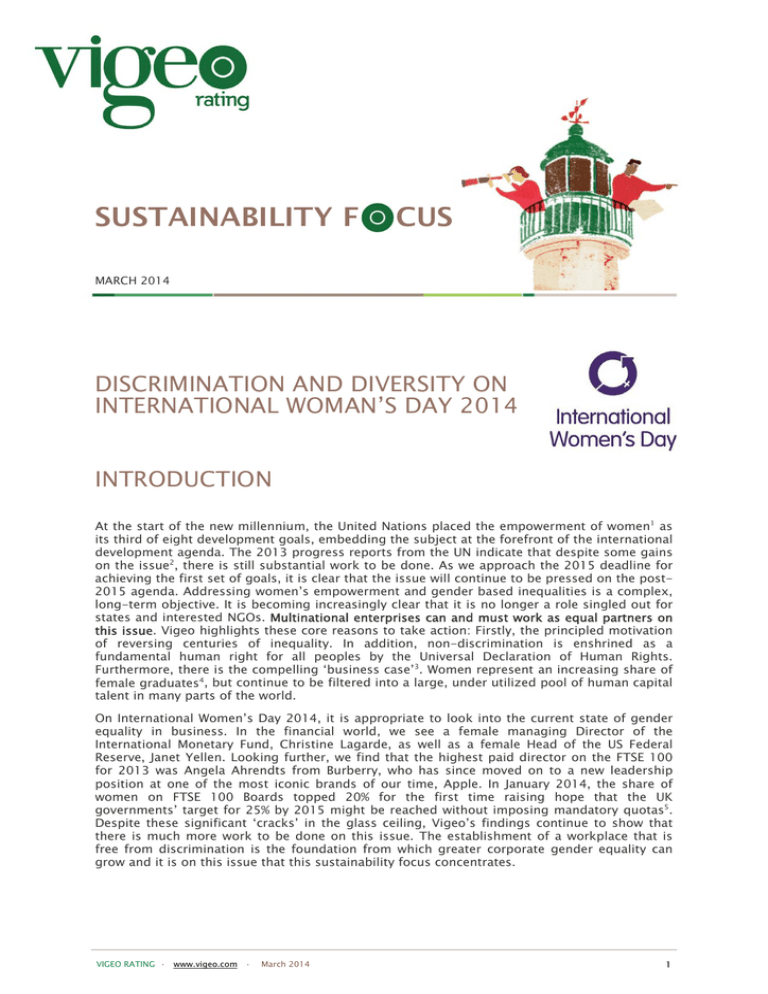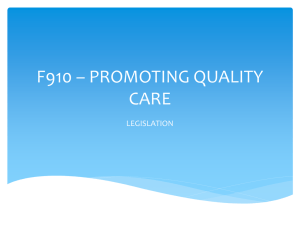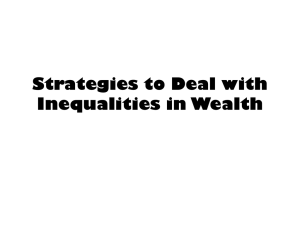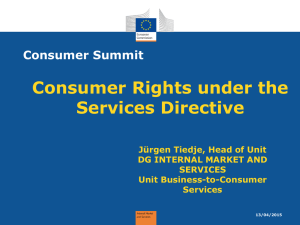
SUSTAINABILITY F
CUS
MARCH 2014
DISCRIMINATION AND DIVERSITY ON
INTERNATIONAL WOMAN’S DAY 2014
INTRODUCTION
At the start of the new millennium, the United Nations placed the empowerment of women1 as
its third of eight development goals, embedding the subject at the forefront of the international
development agenda. The 2013 progress reports from the UN indicate that despite some gains
on the issue2, there is still substantial work to be done. As we approach the 2015 deadline for
achieving the first set of goals, it is clear that the issue will continue to be pressed on the post2015 agenda. Addressing women’s empowerment and gender based inequalities is a complex,
long-term objective. It is becoming increasingly clear that it is no longer a role singled out for
states and interested NGOs. Multinational enterprises can and must work as equal partners on
this issue. Vigeo highlights these core reasons to take action: Firstly, the principled motivation
of reversing centuries of inequality. In addition, non-discrimination is enshrined as a
fundamental human right for all peoples by the Universal Declaration of Human Rights.
Furthermore, there is the compelling ‘business case’3. Women represent an increasing share of
female graduates4, but continue to be filtered into a large, under utilized pool of human capital
talent in many parts of the world.
On International Women’s Day 2014, it is appropriate to look into the current state of gender
equality in business. In the financial world, we see a female managing Director of the
International Monetary Fund, Christine Lagarde, as well as a female Head of the US Federal
Reserve, Janet Yellen. Looking further, we find that the highest paid director on the FTSE 100
for 2013 was Angela Ahrendts from Burberry, who has since moved on to a new leadership
position at one of the most iconic brands of our time, Apple. In January 2014, the share of
women on FTSE 100 Boards topped 20% for the first time raising hope that the UK
governments’ target for 25% by 2015 might be reached without imposing mandatory quotas5.
Despite these significant ‘cracks’ in the glass ceiling, Vigeo’s findings continue to show that
there is much more work to be done on this issue. The establishment of a workplace that is
free from discrimination is the foundation from which greater corporate gender equality can
grow and it is on this issue that this sustainability focus concentrates.
VIGEO RATING • www.vigeo.com •
March 2014
1 Our research has revealed that even among best performing companies6, women continue to
remain under-represented in top management. Moreover, women remain the primary victims
of discrimination and harassment in the workplace. Nearly 40 years after the Sex Discrimination
Act in the UK, the gender gap in terms of pay is an estimated 15%7. In the United States, recent
statistics indicate that women earn an estimated 77 cents for every ‘Man’s Dollar’. These gaps
are not purely sourced by gender inequality, but also reflect traditional employment choices
made by men and women. Absolute statistical equality in all areas between men and women is
not the overarching objective or the best indicator of gender equality but nonetheless, closing
these statistical gaps remains a critical task.
This sustainability focus has been published for several reasons. Firstly, Vigeo has a responsibility to contribute to the ongoing international dialogue on this issue. Secondly, it presents an
opportunity to recognize leading companies on the issue and highlight some innovative practices. Thirdly, we provide a strong argument supporting diversity as a tool to drive operational
performance within a corporation. Finally we draw attention to a key finding of our research,
which has been reiterated across the world, that there are still great lengths to achieve before
reaching the ‘ideal’ level of gender equality in business.
VIGEO’S FINDINGS ON DISCRIMINATION AND
DIVERSITY
Vigeo analyses two key concepts that support
gender equality in its ‘Non-discrimination
and equal opportunities’ sustainability driver.
On one side, we analyse how companies work
to prevent discrimination. Alongside this,
Vigeo analyses how companies work actively
to promote diversity within their workforce.
The data analysed for this sustainability focus
is based on an extraction analysing the
performances of 1,665 companies (699 in
Europe, 474 in North American Region and
492 from the Asian Pacific Region). The data
used is from March 2011 to December 2013.
Vigeo’s top 5 performing companies on Non Discrimination and Equal Opportunities8
VIGEO RATING • www.vigeo.com •
March 2014
2 Share of women in
the Workforce
Share of women in
Share of women at
Top Executive/
Board Level
Management
Team
9
BNP Paribas 70%10
22%
31%
Male
Male
E..ON AG
28%
0%
16%
Male
Male
Red Electrica
20%
N/A11
33%
Male
Male
L’Oréal12
63%
21%
29%
Male
Male
GDF SUEZ
19%
22%
36%
Male
Male
La Banque
Postale
61%
22%13
38%14
Male
Male
Within Vigeo’s top five performers, it is
important to note that three are from a sector
that is traditionally male dominated. GDF
Suez, E.ON AG and Red Electrica are all from
the Electric & Gas Utilities sector. The sector
average of women in the workforce remains
relatively low (approximately 22%), but the
highlighted companies all display proactive
managerial processes in promoting diversity.
Examples include setting targets to integrate
women into management, establishing
divers ity
s upport
s t ructures ,
and
implementing affirmative action programmes.
These companies show that despite their
traditionally male dominated history, they
have challenged the status quo and worked to
promote diversity and gender equality. The
remaining companies are from the Banks and
Luxury Goods and Cosmetics sectors which
appear to be ‘female dominant’ in terms of
the overall composition of the workforce.
CEO
Chairman
A second interesting insight is that all five top
performers
are
European
companies.
Furthermore, within the top 20 performers15
only one American company (Consolidated
Edison16) and one Asian Pacific company
(Stockland17) are listed. This structure
supports our data showing that overall
European companies are leading North
American companies in promoting diversity
and eliminating discrimination.
Lastly, among the top five companies, there
were no female CEOs or Chairs. Indeed, this is
a trend that can be extrapolated across much
of the business world. Within the FTSE 100
there were only four women CEO’s as of late
201318. On the Fortune 1000 index listing
America’s 1000 largest companies on
revenues, women held only 4.6% of CEO
positions as of January 201419. Collectively,
this draws attention to the gender imbalance
that still dominates the business world.
Vigeo’s top performing sectors on the sustainability driver analysing
Non- Discrimination20
Forest Product and Paper Europe and
Automobiles Europe
(55/100)
Chemicals North America
(54/100)
Electric and Gas Utilities Europe
(51/100)
Chemicals Europe / Forest Product and
Paper North America / Waste and Water
Utilities North America
(50/100)
VIGEO RATING • www.vigeo.com •
March 2014
3 The Forest Products and Paper sector in
Europe led the panel with an average sector
score of 55/100. The sector is composed of
six companies, four of which are Scandinavian
(Holmen B, Stora Enso, Svenska Cellulosa and
UPM Kymmene). Scandinavian countries have
a strong reputation in promoting diversity. In
the 2013 Gender Gap Report21 released by the
World Economic Forum, Iceland, Finland,
Norway and Sweden were ranked the top four
countries globally.
The strong performances of the European
Automobiles and Electric and Gas Utilities
sectors again highlight that even in sectors
that are traditionally dominated by men,
ADVANCED
ROBUST
companies can and indeed do lead on the
issue of diversity and non-discrimination in
the workforce.
Globally, Vigeo noted that the average score
for the Universe on the issue of Diversity and
Discrimination was 37/100 which is
considered as limited in absolute terms.
Similarly, the average scores for Europe
(42/100), North America (38/100) and Asia
Pacific (30/100) were all considered as
limited in absolute terms based on Vigeo’s
evaluation levels. Evidently, there is still
significant room for improvement for
corporations across the three regions.
LIMITED
WEAK
Average Score
NonDiscrimination
60+/100
50-59/100
The graphs provided below display the overall
managerial analysis of regional approaches
the issue of diversity and non discrimination.
Vigeo’s
managerial
analysis
looks
at:
Leadership: non discrimination and diversity
policies, their depth and the supporting
structures.
Implementation:
support policies.
the
tools
allocated
to
37/100
0-29/100
From a managerial perspective there is a clear
gap across all regions. The majority of
companies in Europe and North America
appear to have policies in place to deal with
discrimination and diversity. However, the
execution of these policies appears limited
for both regions. The performance results of
both regions decrease further, showing weak
or limited performances. In Asia Pacific, all
aspects of the analysis reflect a weak
performance.
Results: key performance metrics and
allegations (and company reactivity to them).
VIGEO RATING • www.vigeo.com •
March 2014
4 !
BUSINESS RISKS AND OPPORTUNITIES
Vigeo considers that companies who can
work proactively to prevent discrimination
and promote diversity can positively impact
the efficiency of their enterprise in many
ways.
Diversity can first and foremost be used as a
lever to accelerate market penetration.
Companies that are multicultural and
multilingual have the ability to innovate, to
think and to express a wider range of
opinions and approaches to problem solving.
This clearly gives them a competitive edge in
the marketplace. This is particularly pertinent
for ‘B2C’ companies (business to customer
models) such as companies in the cosmetics,
retail, beverage, food and supermarket. In
such models, a diverse workforce is critical to
ensuring that companies can develop not
simply
products but
also
marketing
campaigns that can appeal effectively to a
wider audience and break language and
cultural barriers. Diversity, put simply,
enables companies to talk to more people in
more ways.
Companies can also enhance productivity for
parents who are frequently, the most
productive and senior (in terms of position)
members
of
the
workforce.
Across
management and board rooms, parents are
key constituents driving enterprises forward.
Companies that can provide a working
environment that allows for balance between
private and corporate lives can maximize the
output of this key demographic.
Finally, implementing preventative measures
can
prevent
significant
legal
costs.
Discrimination allegations that lead to legal
proceedings invariably lead to costs for
representation, and in the worse case fines,
penalties, or other settlement costs. The legal
risk varies from region to region. In the USA
for example, large class action lawsuits are
not uncommon. However, even isolated
lawsuits can lead to large payouts. In 2012, a
single ArcelorMittal employee was awarded
USD 25 million in a racism lawsuit.
Furthermore,
by
promoting
diversity,
companies can improve their ability to
respond to workplace talent shortages. By
constructing their image as a welcoming
workplace for women, parents, ethnic
minorities, disabled persons, seniors etc,
companies become more appealing to
potential employees. Given the hiring
competition in certain industries, this again
can provide companies with a competitive
advantage for talent attraction.
Indeed companies that perform well in
relation to diversity and discrimination can
improve their ‘return on human capital
investment’ and retain key talents in the
workforce for longer periods. Companies
frequently invest a significant amount of time
and money in developing employees once
they join the workforce.
How companies
construct their working environment is a key
factor that employees consider when they are
considering their futures within a corporation.
A more inclusive environment is likely to
retain employees, thus allowing companies to
benefit from services for longer. On the flip
side, companies with negative working
environments are likely to experience higher
levels of employee absenteeism and turnover
which undermines operational efficiency.
VIGEO RATING • www.vigeo.com •
March 2014
5 BEST AND INNOVATIVE PRACTICES
• Preventing discrimination should be
integrated in the Code of Conduct as a core
component to ensure that employees
understand the minimum behavioral
standards expected of themselves and their
peers.
• Companies should explicitly define the
managerial processes (hiring, remuneration,
promotion, benefits etc.) that are affected by
non-discrimination principles.
• Reporting systems should be established to
allow
employees
to
formally
and
confidentially record any concerns they might
have.
• The promotion of diversity can be undertaken
by either raising awareness on this issue, or
more formally by providing training to
employees on the nature and benefits of a
more diverse workforce. Such actions can
• PepsiCo has programmes to promote women
in the workplace in the Middle East. In Saudi
Arabia, where women represent less than 5%
of the workforce, the lowest proportion in the
world, the company has constructed
workplaces that respect local customs while
enabling women to work and advance.
• GDF SUEZ has issued a formalised
commitment to non-discrimination in its
Sustainable Development policy and in its
Global Framework Agreement (2010) made
with three trade unions. In June 2012, GDF
SUEZ and multiple stakeholders signed the
Agreement for 2015:
1 executive out of every 3 appointed will
be a woman,
− 35% women at full potential,
− 25% of executives to be women,
− 30% of new recruitments to be women.
−
• Koninlijke DSM has set a range of targets to
promote diversity. These include:
Placing women in at least 21% of
management positions by 2015,
− Placing
BRIC+ nationals 24% of
executive
positions
by
2015.
To help achieve goals, the company
established a ‘Diversity Council’ to
facilitate diversity and support all DSM
businesses in creating a sustainable,
inclusive environment.
−
VIGEO RATING • www.vigeo.com •
March 2014
help
develop
a
wider
corporate
understanding and mindset towards this
idea.
• In addition to this, companies can undertake
affirmative action programmes targeting
specific vulnerable categories (not only
women). Such programmes can provide
vulnerable groups with mentors, networks for
personal
development
and
support
structures.
• Finally companies should track and report
publically on key performance metrics
including (but not limited to) their share of
women in the workforce, women in
management positions, women in executive
teams and women on their Board of
Directors.
• Kelloggs has established an Executive
Diversity and Inclusion Council (EDIC). This
Executive level committee is tasked with
making sure that leaders across its
operations understand the Diversity and
Inclusion priorities of the Company and
execute plans to achieve them. From 2013,
representatives from under-represented
groups are able to attend segments of the
EDIC meetings in order to foster more
dialogue on Diversity and Inclusion topics
and opportunities across the business.
• Lonmin Plc has established a ‘Women in
Mining’ program in conjunction with the
International Finance Corporation (part of the
World Bank Group). The Company states that
it has recognised that skilled female
graduates are quickly absorbed into high
paying jobs and , while mining is prepared to
pay high premiums, the mining industry is
still branded as masculine and not attractive
to female candidates. To break the norm,
Lonmin has provided documents detailing
how companies can work to culturally
transform the workplace making it more
attractive to skilled women. Some of the
concrete steps advocated include securing
incentives for women, conducting risk
assessments for women in all jobs, providing
career development support, alternative
placements systems for pregnant women and
new mothers, and sexual harassment training
sessions.
6 CONCLUSIONS
Unlike other emerging CSR issues22, the
topics of non-discrimination and gender
equality have been a part of corporate
responsibility agendas for many years.
Nonetheless, the macro-trend of Vigeo’s
assessment shows that both global and
regional performances remain limited. The
top five sectors in the rating universe are only
attaining scores of 50-55/100, which are
considered robust but not yet advanced. The
vast majority of sectors appear limited in
terms of their overall performance. European
companies and sectors display better
performances than their North American
counterparts,
but
there
are
clearly
improvements that can be made across the
different regions. Achieving greater gender
equality requires that a fundamental baseline
of non-discrimination in the workplace is
established. On the micro-trend perspective,
sectors where the share of women in the
workforce outnumbers men, the absolute
share of women at top levels of management
remains low.
There are positive elements to our analysis as
well. The strong performances of electric and
gas utility sector and the automobile sector
indicate that there are isolated sectors where
concerted efforts are being made and positive
impacts are being created. This is expanding
the potential number of places in which
women are able to work free from
discrimination, and therefore expanding
economic possibilities for women. The best
practice of the mining company Lonmin Plc is
one of many examples of how companies are
opening up new routes to revenues for
women.
This sustainability focus has also drawn
attention to the idea that there is a strong
‘business
case’
for
promoting
nondiscrimination and diversity in the workplace,
which should spur companies into greater
and more persistent action. Companies can
drive increased efficiency, productivity,
improve their return on human capital
investment, increase their ability to penetrate
new markets and target new consumers. By
becoming more diverse, more multilingual
and more multicultural companies can
become more competitive.
On International Woman’s Day 2014 we can
take a look back with some satisfaction at
over a century of progress but more
importantly, we must continue to look to the
future and demand more cooperation from
governments, international institutions, NGOs
and companies. As we move closer to
establishing a new set of development goals
for the international community to focus
upon, gender empowerment must continue to
be considered a priority.
CONTACTS
For further information, please contact:
Keeran Gwilliam-Beeharee keeran.gwilliam-beeharee@vigeo.com
Zineb Raji zineb.raji@vigeo.com
Emma Doner emma.doner@vigeo.com
Jordi Lesaffer jordi.lesaffer@vigeo.com
DISCLAIMER
All rights reserved. Reproduction and dissemination of material in this report for educational or other
non-commercial purposes are authorized without any prior written permission from Vigeo provided
the source is fully acknowledged. Reproduction of material in this report for resale or other commercial purposes is strictly prohibited without written permission of Vigeo.
ANNEX: Vigeo’s Top 20 Companies on Non-Discrimination 2014.
(1) BNP Paribas (93/100) (2) E.ON AG (91/100) (3) RED ELECTRICA (88/100) (4) L’Oreal (87/100)
(4 =) GDF SUEZ (4 =) La Banque Postale (5) TFI (82/100) (5=) Consolidated Edison (5 =) Intesa
Sanpaolo (6) Veolia (81/100) (6 =) Sodexo (7) Linde AG (80/100) (7=) European Investment
Bank (7=) Rexel (7=) Fonc Des Regions (7=) Stockland (7=) Orange (7=) Danone (7=) Umicore
(8) BIC.
VIGEO RATING • www.vigeo.com •
March 2014
7 Notes and Sources
1) Goal Number 3 of the MDGs is to ‘Promote Gender Equality and Empower Women’.
2) Millennium Development Goals: 2013 Progress Chart – www.unitednations.org ( http://www.un.org/
millenniumgoals/pdf/report-2013/2013_progress_english.pdf )
3) See the section of this sustainability focus on ‘Opportunities’.
4) See Women Moving Millions website – www.womenmovingmillions.org
In the USA: Women represent 51% of PHDs in the USA, 51% of business school appliants, 67% of college
graduates, 70% of Valedictorians.
See also – ‘Degrees of equality’ – www.theeconomist.com – 13/09/2011
See also the Russell Sage Foundation ‘The Rise of Women: Seven Charts Showing Women’s Rapid Gains in
Educational Achievement’. www.russellsage.org .
5) See the Financial Times; ‘Proportion of women on FTSE 100 Boards tops 20%’ – www.ft.com – 17/01/2014
6) In terms of their performance on Vigeo’s sustainability driver that analyses ‘Non Discrimination’.
7) Statistics from the Fawcett Society, the UK’s leading campaigning organization for women’s equality and rights
– www.fawcettsociety.org
8) Figures are based on Vigeo’s internal information and information from Corporate websites as of February
2014. Calculations include employee representatives. Due to different Governance structures, these figures are
not directly comparable.
9) Figures supplied by BNP Paribas to Vigeo.
10) The figures for the ‘workforce’ are for the French segment of the company, the other figures refer to the
Group as a whole.
11) The company does not appear to have an executive management team in a traditional sense.
12) Figures supplied by L’Oreal to Vigeo.
13) The Company’s ‘Operational Committee Members’ considered here.
14) The combined ‘Executive Board Members + Regional Bank Representatives’ considered here (16 members)
15) See the annex to this Sustainability Focus (Figure 1).
16) Electric and Gas Utilities North America
17) Financial Services and Real Estate Asia Pacific
18) ‘New Severn Trent CEO lifts women FTSE 100 bosses to four’ – www.reuters.com- November 18th 2013
19) ‘Women CEOs of Fortune 1000’ – www.catalyst.com – 05/01/2014
20) A breakdown of our top 20 companies is provided in the Annex of this sustainability focus
21) ‘The Gender Gap Report 2013’ – The World Economic Forum http://www3.weforum.org/docs/
WEF_GenderGap_Report_2013.pdf013
22) Such as the management of nanotechnologies, dealing with stress at work, the integration of CSR into
governance and Human Rights due diligence in Supply Chains.
VIGEO RATING • www.vigeo.com •
March 2014
8










